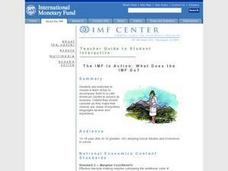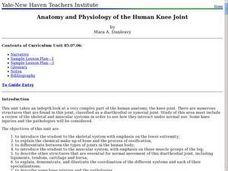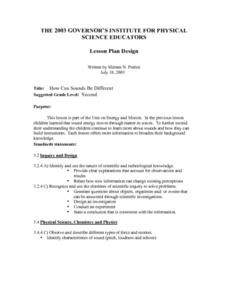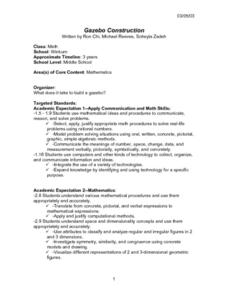Curated OER
The Periodic Table of Elements
Eleventh graders study the use of the periodic table to develop a better understanding of the chemical elements.
Curated OER
Map Literacy
Students locate their home state on a map. They differentiate between physical and population sizes of states. In two groups, students "become" states with string for boundaries. They ascertain that area does not always equal large...
Curated OER
Kids Count
Students read special purpose map, use place value to hundred thousands, and write numbers to hundred thousands.
Curated OER
My Favorite Birthday
Students collect and organize data from classmates, display data on simple chart, and plan class birthday party.
Curated OER
Birds of a Feather
Students investigate birds and complete a variety of bird-themed activities. They read books and observe birds noting their physical characteristics, development and life cycle stages.
Curated OER
Looking Inside Cells
Seventh graders analyze and identify the role of the cell membrane and nucleus. They create flash cards to help them review cell structures. They also compare plant and animal cells.
Curated OER
The IMF in Action: What Does the IMF Do?
Students use newspapers and the internet to discover what the IMF does. They work together in groups to brainstorm occupations which need another language to be spoken. They also examine data related to trading among countries.
Curated OER
Populations and Ecosystems
Sixth graders define terms prey, predator, and scavenger, describe predator-prey relationship, discuss effects of a lack of predators in an environment, and separate the role of the scavenger from that of the predator.
Curated OER
Anatomy and Physiology of the Human Knee Joint
Learners examine human anatomy with a focus on the knee joint. In groups, they research the chemical makeup of human bones and explain the different types of joints found in the body. To end the lesson plan, they identify the other...
Curated OER
Five Kingdoms of Living Things
Fifth graders are introduced to the classification system used in Science. In groups, they explain the characteristics of each of the five kingdoms. After watching a video, they review the life processes of each kingdom and complete a...
Curated OER
Transportation History
Students research the major developments in transportation. In groups, they use this information to plot them on a timeline. They also write a paragraph about how advances in technology have changed the world. As a class, they discuss...
Curated OER
Astronomy
Middle schoolers brainstorm about what they know about the solar system. They study a planetary fact sheet and create a Venn Diagram with the information. They work in groups to examine the names of the planets and information regarding...
Curated OER
Huey and Louie Meet Dewey
Pupils exercise their library shelving skills. Students complete a worksheet that aids a rambunctious student who needs their help. Pupils become familiar with the Dewey decimal classification system. Students organize books on the shelves.
Curated OER
Lake and Pond Study
Students examine the habitat and community structure of a pond that could support Ospreys through games and worksheets. They then go on a field trip to a pond to evaluate the suitability of the pond as an Osprey habitat.
Curated OER
Deciphering Community
Middle schoolers explore the concept of a community. They identify and group various kinds of communities. Students create a concept map exemplifying their membership in different communities. They write a narrative describing their...
Curated OER
Patterns in Dance
Third graders perform a line dance in the study of math as a pattern. They create and discuss movement solutions derived from movement exploration. They observe that patterns exist in the areas of music and dance and follow the...
Curated OER
How Can Sounds Be Different
Second graders explore energy and motion. They investigate how sound energy moves in waves. Students explore how sounds are varied and how the instruments that make those sounds are built. They observe sounds being produced and predict...
Curated OER
Why Do We Have Thanksgiving?
Pupils investigate the change in the Thanksgiving holiday over time. They research the Native Americans and Pilgrims to find out how their relationship affected the holiday. They create a PowerPoint presentation using digital cameras...
Curated OER
Gazebo Construction
Students create and give oral proposals for the construction of a gazebo using a blueprint created with Geometer's Sketchpad. They then build a gazebo model using the blueprints created and provide evidence why it should be selected for...
Curated OER
What's Your Design?
Sixth grade students: design a stained glass window, submitting their initial plan detailing the measurements of all lines and angles. Seventh grade students: create a scale drawing of their own geometric family of four members.
Curated OER
Down, Dung and Dirty
Students investigate the stages of succession in animal dung communities. They create a dung culture using fresh cow, goat or horse dung then record data on the fungal species that appear over a two week period.
Curated OER
Plant Classfications
Seventh graders observe and discuss as a class the different types of vascular plants. They examine the different parts of the plant and some of the processes occurring in plants with activities accompanying.
Curated OER
Exploring Vaccines
Students explain in a written format how vaccination works and how it draws upon the natural immunity. They differentiate between vaccinations and immunizations. Students identify a number of illnesses that can be prevented by the use of...
Curated OER
Great Salt Lake
Fourth graders make an ecosystem that brine shrimp can live in and take data as to what level of salinity the water is, how cold it is, and other data that students may think is important. They also hypothesize and predict the outcomes...























